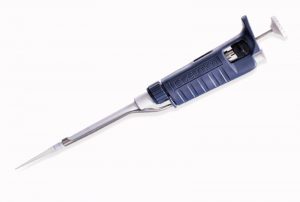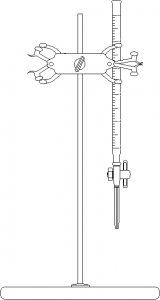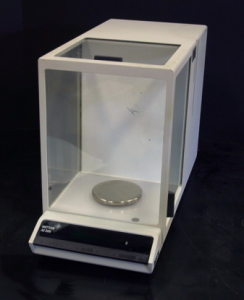There are many hazards in the general chemistry lab that you need to be familiar with before you get started on your experiments. The hazards you will encounter during the semester include: chemicals, fire, pressurized gases, and sharp objects. Additionally, working in Bicentennial Hall in proximity with other laboratories requires a working knowledge of emergency procedures. Safety in the Laboratory at Middlebury College is overseen by the Environmental Health and Safety Working Group. Based on their recommendations, which can be accessed at their website, this webpage provides an overview of the most relevant information for the CHEM 103 laboratory. More specific information will be provided as needed during the semester.
Bicentennial Hall Safety
Fire alarms
In the event that a fire alarm is activated:
- If possible, shut down and/or secure your experiment. This includes shutting off the gas, putting chemicals in the fume hoods, and closing the fume hoods;
- If possible, collect essential belongings because you may not return to the classroom for several hours;
- Evacuate the building via the nearest exit;
- Check-in with your instructor outside of the building.
Telephones
Bicentennial Hall classrooms are equipped with telephones so we can call for help. Emergency phone numbers are listed next to the telephone.
Automated external defibrillator (AED)
In the event of a medical emergency, an AED is located in the Great Hall on the second floor of Bicentennial Hall. If an AED is needed, 911 should be called directly for immediate medical assistance.
Laboratory Housekeeping
Laboratory instructors and students are directly responsible for the cleanliness of their workspaces, and jointly responsible for common areas of the laboratory.
- Access to walkways, exits, fire extinguishers, eyewashes, emergency showers, electrical disconnect panels, first-aid kits, and any other emergency equipment must remain unobstructed at all times. Access paths must not be used for storage of any kind, not even for carts or other portable items;
- Keep floors clean and dry;
- All incidental spills on laboratory benches or floors shall be immediately cleaned and appropriately disposed of;
- Each laboratory worker shall keep their work area clean and uncluttered, with laboratory benches kept clear of unnecessary equipment and chemicals;
- At the completion of each experiment or operation, the work area shall be thoroughly cleaned, with all equipment properly cleaned and stored, and chemicals returned to their assigned storage areas.
Chemical Safety
The Middlebury Chemical Hygiene Plan is available here. This content is based on the chemical hygiene plan.
Protective Equipment
Clothing and Hair: Clothing worn while working in the laboratory should offer protection from chemical splashes and spills, and should be easily removable in case of an accident. It is recommended that laboratory workers wear pants or clothing that covers the legs; shorts and short skirts are discouraged. Loose or flowing clothing and clothing made of flammable polymeric fabrics should be avoided. Clothing that completely covers the hands, arms and legs should be worn when working with any hazardous material that may cause skin irritation, burns, allergic reactions or has the ability to penetrate skin. Long hair should be secured while working to avoid unintended contact with chemicals or unguarded equipment.
Footwear: Footwear is required in laboratories at all times. The use of closed-toe, closed-heel, solid top shoes is strongly encouraged. Some laboratories may require closed-toe footwear in order to enter. High-heeled shoes, and shoes made of woven or porous material are not recommended while working in the laboratory, particularly if working with hazardous material that may cause skin irritation, burns, allergic reactions, or has the ability to penetrate the skin. Sandals, flip-flops and bare feet are expressly forbidden.
Eye and Face Protection: Eye and face protection is required anytime there is potential exposure to liquid chemicals, acids and caustic liquids, hazardous chemical gases or vapors, or potentially hazardous light radiation, such as UV radiation. Eye and face protection for a particular laboratory process should be selected based on the potential for exposure or damage to the eyes and face. Appropriate eye protection is required for all employees, students, and visitors to the laboratory, and shall be worn at all times when there is potential exposure to hazards. Chemical splash goggles are required to be worn by all laboratory workers in any laboratory where transfer and handling operations occur that involve use of the following materials: liquids capable of causing injury or disease if sprayed or splashed in the eye or highly-toxic chemicals. In laboratories where there is no possibility of injury due to spray or splash of hazardous liquids, safety glasses may be worn instead of splash goggles.
Hand Protection: Appropriate gloves shall be worn whenever there is a possibility of skin contact with chemicals or exposure to other hazards. Laboratory Supervisors will ensure that the selected glove material and type of construction is suitable for the substance being handled and the procedure to be used. Potentially-contaminated gloves must be removed before handling or contacting any objects in the laboratory that should not be contaminated, such as doors, telephones, pens, and computer keyboards. All gloves must be removed before leaving the laboratory and entering public areas and hallways. Disposable gloves (nitrile and latex) should never be reused.
Laboratory Coats: Laboratory coats are recommended, and may be required, when working in the laboratory, depending on the intended procedures. Laboratory coats should be buttoned at all times and removed immediately if they become contaminated. Laboratory coats and laundry services are available at no cost from Laboratory Stores.
Chemical Equipment and Glassware
The following procedures shall apply to the use of laboratory equipment and glassware:
- All laboratory equipment is to be used only for its intended purpose;
- Broken, cracked, or chipped glassware shall be immediately disposed in a labeled broken glass receptacle;
- All evacuated glass apparatus such as vacuum manifolds should be used in a hood, or otherwise protected or shielded to contain chemicals and glass fragments in the event of an implosion;
- Laboratory equipment should be inspected periodically and repaired or replaced as necessary.
Chemical and Waste Labeling
All chemical containers in the laboratory must be properly labeled. Dispensing of chemicals into secondary containers requires that the secondary containers be labeled with the full name of the chemical. An exemption from labeling requirements is made for transferring a chemical from a labeled container into another container, such as a beaker or Erlenmeyer flask, where the chemical is solely for the immediate use of the worker who performed the transfer and the container is in the control of the user at all times.
Chemical Disposal
Generally, materials suitable for drain disposal in limited quantities must meet the following physical and chemical criteria:
- They are liquid and readily water soluble (soluble at 3% concentration);
- Easily biodegradable;
- Simple salt solutions of low toxicity inorganic substances;
- Dilute organic substances of low aquatic toxicity and concentration of 5% or less.
The following materials should never be poured down drains or placed in regular trash as a method of disposal:
- Oil, grease, petroleum or other water insoluble chemicals;
- Compounds that could result in the presence of toxic gases or vapors;
- Water reactive materials;
- Water soluble polymers that could form gels in the sewer system;
- Malodorous compounds or volatile organic chemicals that can cause exposures or obnoxious odors;
- Any waste that could impart color that cannot be removed by the Town of Middlebury Wastewater Treatment Facility (i.e. dye wastes and stains);
- Toxic chemicals such as carcinogens, mutagens, teratogens;
- Flammable materials (flashpoints less than 140°F) unless sufficiently diluted in water as part of the laboratory process such that the solution has a residual flashpoint greater than 140°F;
- Heavy metal compounds;
- Phosphoric acid or phosphates.
Chemical Spill Response
Incidental Spills: Incidental spills are small spills that do not pose a significant safety or health hazard to lab workers in the immediate vicinity or to the worker cleaning it up. Incidental spills do not require an emergency response and may be cleaned up by employees working in the area if it can be done safely and easily and spill response materials are available. Any incidental spill shall be immediately cleaned up and cleanup materials properly disposed. Appropriate personal protective equipment (PPE) must be worn while cleaning up incidental spills.
Personnel shall immediately contact the Chemical Hygiene Officer, Laboratory Stores and Safety Manager, or the Director of Sciences Support Services for a spill that meets one or more of the following criteria:
1. The volume is large, cannot be contained, or exceeds the capacity of cleanup materials available in the laboratory;
2. May result in chemical exposure or injury;
3. Presents an immediate hazard (fire, explosion, chemical exposure, etc.);
4. Involves a highly dangerous chemical, including acutely hazardous or toxic materials; or
5. Is a spill of an unknown material.
Safety and Emergency Equipment
Safety and Emergency Equipment Safety and emergency equipment is provided in or near all laboratories. Pathways to and access to this equipment must never be blocked or obstructed. Laboratory personnel should familiarize themselves with the location and proper use of safety and emergency equipment, including fire extinguishers, gas shutoff valves, emergency showers, and eyewash stations. Specific training in the use of fire extinguishers is available through the College’s Environmental Health and Safety Office.
Eyewash Stations: Emergency eyewash stations are provided in or near all laboratories where hazardous materials may be used.
Safety Showers: Emergency showers are provided in or near all laboratories.
Fire Extinguishers: Fire extinguishers are located in or near all laboratories. Fire extinguishers in laboratories are generally BC type, which are suitable for fires caused by flammable liquid fires such as grease or gasoline, and electrical fires. These extinguishers are not appropriate for fires involving metals such as magnesium, sodium or potassium.
Chemical Spill Response Kits: Chemical spill response kits and sorbent materials are available in the laboratory.
First Aid Kits: Laboratories are equipped with a basic first aid kit containing bandages and disinfectant wipes to treat minor cuts, scrapes, abrasions and burns.
Fume Hoods: Use of a laboratory fume hood is recommended for any work with volatile chemicals. A fume hood is to be utilized for all chemical procedures which might result in release of hazardous chemical vapors, mists, or dusts.
- In the event of a spill, smoke, or other unintended vapors, press the emergency purge button to increase to maximum fan speed;
- Keep the sash of the hood lowered at all times except when making adjustments to apparatus within the hood. This is to prevent vapors from spilling out of the hood, and also to provide containment in the event of a vigorous or runaway reaction;
- KEEP FACE AND HEAD OUTSIDE OF THE FUME HOODS when chemicals are in use or chemical processes are occurring;
- Items inside the hood should always be kept to a minimum, and should be limited to the chemicals, apparatus, or other items being used in the immediate procedure. Working hoods should not be used as a storage area for chemicals or waste unless designated for that purpose;
- Minimize interference with the inward flow of air into the hood by keeping apparatus and reagent bottles at least 6 inches (15 cm) back from the hood face, and ensuring that the exhaust slots at the rear of the hood are not blocked.
Safety Data Sheets: Safety Data Sheets (SDS) provide standardized information for chemicals. SDS include chemical names, hazardous ingredients, physical and chemical characteristics, fire and explosion hazard data, reactivity data, health hazard data, precautions for safe handling and use; and control measures. A copy of any required SDS shall be readily accessible in the laboratory where the chemical is used. SDS sheets shall be available 24 hours a day, in case of an emergency. Middlebury College will retain a copy of each Safety Data Sheet (SDS) for laboratory chemicals sent by the manufacturer, and will make a reasonable effort to obtain an appropriate SDS for all other commercial laboratory chemicals. SDSs for substances used in Bicentennial Hall laboratories will be maintained in a central file in the Laboratory Stores or electronically.



